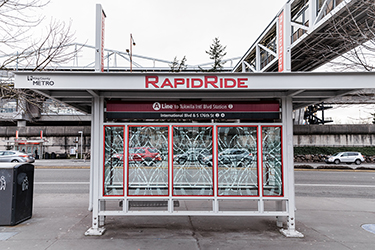|
Subscribe / Renew |
|
|
Contact Us |
|
| ► Subscribe to our Free Weekly Newsletter | |
| home | Welcome, sign in or click here to subscribe. | login |
Architecture & Engineering
| |
 |
October 3, 2019
What our evolving mobility options mean for designers and developers
DKS Associates

Chandler
|
There are myriad transportation policies and emerging technologies associated with development, both traditional and progressive, that need to be dealt with during development, planning and design phases.
Whether a developer is planning for city and neighborhood development or a single building, transportation needs will impact the decision-making process. Planners and developers must understand these key transportation issues and opportunities as they develop spaces to live, work and play.
Transit-oriented development
As cities continue to grow in the Northwest, so does the need for greater access to transit.
Urban dwellers desire walkability, which will continue to lead developers to take pedestrian issues into account by building mixed-use communities. Transit-oriented development reduces space for parked cars while creating a “sense of space” for those who live and visit these developments.
There is a growing trend for developers to help fund public improvements directly related to their residential and commercial projects — especially here in the Northwest. Examples include sidewalks, bicycle lanes, bus stops and electric vehicle charging stations.
DKS consults with local municipalities to identify future mobility needs at a new or renewed development site, assesses the impact of that development, and assesses appropriate fees to ensure the project succeeds from a transportation standpoint.
Reducing pollution from automobile use increases the LEED score for every LEED category. Developers can encourage reduced vehicle travel by selecting sites close to transit, developing pedestrian and bike paths, reducing parking facilities, and adding electric vehicle charging infrastructure, thus reducing its carbon footprint.
The Living Building Challenge includes evaluating transportation impacts and pollution, while promoting people-powered modes of travel including walking and bicycling, supplemented with shared transit. Other recommended solutions include transit subsidies and infrastructure. The Living Building Challenge also focuses on equity, requiring equal access to all primary transportation regardless of socioeconomic status.
For new development, and increasingly as a retrofit, electric vehicle infrastructure is becoming a need as the fleet of electric vehicles continues to grow nationwide. As we progress towards more vehicle electrification, architects and developers need to account for this trend and install electric vehicle chargers for residents, employees and visitors.
Getting EV-ready
One of the most significant changes to transportation is the effort to reduce our carbon footprint by converting from fossil fuel to electrically powered vehicles. Seattle is among a few cities that are leading this charge under its Drive Clean Seattle initiative and Climate Action Strategy.
This year, Seattle passed sweeping new amendments to the city’s land use code requiring new construction to be “EV-ready,” requiring the installation of wiring and power outlets in new off-street parking to support future EV chargers.
Specific requirements depend upon the type of land use and type and number of parking facilities provided. For example, at least 20% of parking stalls in shared lots and garages for large multifamily housing must be wired with 208/240 volt, 40-amp power to support Level 2 chargers. For smaller projects, the ratios are higher including at least one pre-wired parking stall for each new single-family home or townhouse. For nonresidential uses, at least 10% of parking facilities must be EV-ready.
This is an important change relative to previous vehicle electrification requirements that were limited to the electrical code, which only required physical capacity for future upgrades but no actual infrastructure, and single-family homes and duplexes were exempt.
Parking demand is beginning to fall in urban areas as citizens seek other travel modes. In order to determine actual parking needs, developers can work with cities to conduct parking demand and utilization surveys, projection of future parking demand, management strategies (such as dynamic pricing), payment strategies, signage/wayfinding, and identification of potential parking facility sites. Some communities are relaxing current “parking minimums” for new developments and redeveloped areas near bus, light rail and heavy rail facilities. LEED encourages minimizing the construction of parking facilities.
Transportation and development will need to work hand-in-hand as the Northwest densifies and technology continues to shape our engagement with the built environment. By keeping up with the state of the practice in transportation-related facilities, developers will improve their ability to meet client needs — which directly affects the bottom line.
Brian Chandler is the director of transportation safety for DKS Associates.
Other Stories:
- Why electric scooters could be a game changer for Seattle
- CLT: construction’s lean, green beauty queen
- The AEC industry has a data problem
- New OSU-Cascades academic building will aim for net zero
- Mass timber is bringing the warmth of wood to the workplace
- With so many tech advances, why has AEC productivity growth stalled?
- Survey: Cary Kopczynski & Co.
- Survey: Weber Thompson
- Survey: Johnston Architects
- Survey: Bohlin Cywinski Jackson
- These 3 Northwest projects show how listening to clients pays off
- Which project delivery methods work best?
- How understanding building codes can help you get more out of your project
- How successful workplaces offer more than just a place to work



